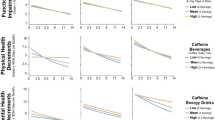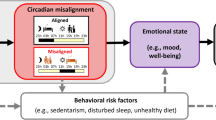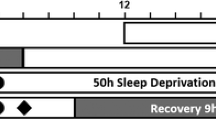Abstract
Rationale
Methamphetamine attenuates disruptions that occur after changes in work shifts. The reinforcing effects of the drug during shift work have yet to be characterized.
Objectives
This study examined methamphetamine-related mood, performance, and reinforcing effects during simulated shift work.
Materials and methods
Ten volunteers (four women and six men) completed this 19-day study. Participants were given an opportunity to self-administer oral methamphetamine (10 mg) or receive a $1 voucher before and after an 8-h work period for four consecutive days under two shift conditions: (1) “day shift” in which they went to bed at 2400 hours and woke up at 0800 hours and (2) “night shift” when they went to bed at 1600 hours and woke up at 2400 hours. Thus, participants completed task batteries either from 0815 to 1715 hours or from 0015 to 0915 hours. Shift conditions alternated three times during the study and were separated by an “off” day.
Results
Night-shift work disrupted psychomotor task performance and some ratings of mood, especially on the first night. Consistent with this, participants chose to take methamphetamine significantly more often on the first night-shift night compared with the first day-shift day. Regardless of shift condition, however, participants selected markedly more methamphetamine doses before the work period than after it (73% versus 34%).
Conclusions
These data show that methamphetamine self-administration occurred more often before work rather than after work, suggesting that the use of stimulants by shift workers may be one strategy employed to meet behavioral demands especially under conditions engendering poor performance, fatigue, and/or sleep disruptions.



Similar content being viewed by others
References
Ajilore O, Stickgold R, Rittenhouse CD, Hobson JA (1995) Nightcap: laboratory and home-based evaluation of a portable sleep monitor. Psychophysiology 32:92–98
Baranski JV, Pigeau RA (1997) Self-monitoring cognitive performance during sleep deprivation: effects of modafinil, d-amphetamine and placebo. J Sleep Res 6:84–91
Cantero JL, Atienza M, Stickgold R, Hobson JA (2002) Nightcap: a reliable system for determining sleep onset latency. Sleep 25:238–245
Cho AK, Melega WP, Kuczenski R, Segal DS (2001) Relevance of pharmacokinetic parameters in animal models of methamphetamine abuse. Synapse 39:161–166
Comer SD, Haney M, Foltin RW, Fischman MW (1996) Amphetamine self-administration by humans: modulation by contingencies associated with task performance. Psychopharmacology (Berl) 127:39–46
Comer SD, Hart CL, Ward AS, Haney M, Foltin RW, Fischman MW (2001) Effects of repeated oral methamphetamine administration in humans. Psychopharmacology (Berl) 155:397-404
Couper FJ, Pemberton M, Jarvis A, Hughes M, Logan BK (2002) Prevalence of drug use in commercial tractor-trailer drivers. J Forensic Sci 47:562–567
Crowley SJ, Lee C, Tseng CY, Fogg LF, Eastman CI (2004) Complete or partial circadian re-entrainment improves performance, alertness, and mood during night-shift work. Sleep 27:1077–1087
de Wit H, Uhlenhuth EH, Johanson CE (1985) Drug preference in normal volunteers: effects of age and time of day. Psychopharmacology (Berl) 87:186–193
Doty P, de Wit H (1995) Effect of setting on the reinforcing and subjective effects of ethanol in social drinkers. Psychopharmacology (Berl) 118:19–27
Eastman CI, Martin SK (1999) How to use light and dark to produce circadian adaptation to night shift work. Ann Med 31:87–98
Foltin RW, Fischman MW, Brady JV, Kelly TH, Bernstein DJ, Nellis MJ (1989) Motivational effects of smoked marijuana: behavioral contingencies and high-probability recreational activities. Pharmacol Biochem Behav 34:871–877
Fransen M, Wilsmore B, Winstanley J, Woodward M, Grunstein R, Ameratunga S, Norton R (2006) Shift work and work injury in the New Zealand Blood Donors’ Health Study. Occup Environ Med 63:352–358
Gold DR, Rogacz S, Bock N, Tosteson TD, Baum TM, Speizer FE, Czeisler CA (1992) Rotating shift work, sleep, and accidents related to sleepiness in hospital nurses. Am J Public Health 82:1011–1014
Hakkanen H, Summala H (2000) Sleepiness at work among commercial truck drivers. Sleep 23:49–57
Haney M, Ward AS, Comer SD, Hart CL, Foltin RW, Fischman MW (2001) Bupropion SR worsens mood during marijuana withdrawal in humans. Psychopharmacology (Berl) 155:171–179
Hart CL, Ward AS, Haney M, Foltin RW, Fischman MW (2001) Methamphetamine self-administration by humans. Psychopharmacology (Berl) 157:75–81
Hart CL, Ward AS, Haney M, Foltin RW (2003a) Zolpidem-related effects on performance and mood during simulated night-shift work. Exp Clin Psychopharmacol 11:259–268
Hart CL, Ward AS, Haney M, Nasser J, Foltin RW (2003b) Methamphetamine attenuates disruptions in performance and mood during simulated night-shift work. Psychopharmacology (Berl) 169:42–51
Hart CL, Haney M, Nasser J, Foltin RW (2005) Combined effects of methamphetamine and zolpidem on performance and mood during simulated night shift work. Pharmacol Biochem Behav 81:559–568
Hart CL, Haney M, Vosburg SK, Comer SD, Gunderson E, Foltin RW (2006) Modafinil attenuates disruptions in cognitive performance during simulated night-shift work. Neuropsychopharmacology 31:1526–1536
Johanson CE, de Wit H (1992) Lack of effect of social context on the reinforcing effects of diazepam in humans. Pharmacol Biochem Behav. 43:463–469
Jones HE, Garrett BE, Griffiths RR (2001) Reinforcing effects of oral cocaine: contextual determinants. Psychopharmacology (Berl) 154:143–152
Kelly TH, Foltin RW, Emurian CS, Fischman MW (1993) Performance-based testing for drugs of abuse: dose and time profiles of marijuana, amphetamine, alcohol, and diazepam. J Anal Toxicol 17:264–272
Kelly TH, Foltin RW, Mayr MT, Fischman MW (1994) Effects of delta 9-tetrahydrocannabinol and social context on marijuana self-administration by humans. Pharmacol Biochem Behav 49:763–768
McLeod DR, Griffiths RR, Bigelow GE, Yingling J (1982) An automated version of the digit symbol substitution test (DSST). Behav Res Meth Instr 14:463–466
McMenamin TM (2007) A time to work: recent trends in shift work and flexible schedules. Mon Labor Rev 120(12):3–15
Miller TP, Taylor JL, Tinklenberg JR (1988) A comparison of assessment techniques measuring the effects of methylphenidate, secobarbital, diazepam and diphenhydramine in abstinent alcoholics. Neuropsychobiology 19:90–96
Muehlbach MJ, Walsh JK (1995) The effects of caffeine on simulated night-shift work and subsequent daytime sleep. Sleep 18:22–29
Ohayon MM, Lemoine P, Arnaud-Briant V, Dreyfus M (2002) Prevalence and consequences of sleep disorders in a shift worker population. J Psychosom Res 53:577–583
Perez A, Kirkpatrick MG, Gunderson EW, Marrone G, Silver R, Foltin RW, Hart CL (2008) Residual effects of intranasal methamphetamine on sleep, mood, and performance. Drug Alcohol Depend 94:258–262
Reid K, Dawson D (2001) Comparing performance on a simulated 12 hour shift rotation in young and older subjects. Occup Environ Med 58:58–62
Sharkey KM, Fogg LF, Eastman CI (2001) Effects of melatonin administration on daytime sleep after simulated night shift work. J Sleep Res 10:181–192
Silverman K, Kirby KC, Griffiths RR (1994a) Modulation of drug reinforcement by behavioral requirements following drug ingestion. Psychopharmacology (Berl) 114:243–247
Silverman K, Mumford GK, Griffiths RR (1994b) Enhancing caffeine reinforcement by behavioral requirements following drug ingestion. Psychopharmacology (Berl) 114:424–432
Smith A (2002) Effects of caffeine on human behavior. Food Chem Toxicol 40:1243–1255
Stoops WW, Lile JA, Fillmore MT, Glaser PE, Rush CR (2005a) Reinforcing effects of methylphenidate: influence of dose and behavioral demands following drug administration. Psychopharmacology (Berl) 177:349–355
Stoops WW, Lile JA, Fillmore MT, Glaser PE, Rush CR (2005b) Reinforcing effects of modafinil: influence of dose and behavioral demands following drug administration. Psychopharmacology (Berl) 182:186–193
Substance Abuse and Mental Health Services Administration (SAMHSA) (2007) Office of Applied Studies. Treatment Episode Data Set (TEDS) Highlights—2006 National Admissions to Substance Abuse Treatment Services. OAS Series #S-40, DHHS Publication No. (SMA) 08-4313, Rockville, MD
U.S. Congress, Office of Technology Assessment (1991) Biological rhythms: implications for the worker. US Government Printing Office, Washington
Walsh JK, Muehlbach MJ, Humm TM, Dickins QS, Sugerman JL, Schweitzer PK (1990) Effect of caffeine on physiological sleep tendency and ability to sustain wakefulness at night. Psychopharmacology (Berl) 101:271–273
Wesnes K, Warburton DM (1983) Effects of smoking on rapid information processing performance. Neuropsychobiology 9:223–229
Wiegmann DA, Stanny RR, McKay DL, Neri DF, McCardie AH (1996) Methamphetamine effects on cognitive processing during extended wakefulness. Int J Aviat Psychol 6:379–397
Williamson A (2007) Predictors of psychostimulant use by long-distance truck drivers. Am J Epidemiol 166:1320–1326
Acknowledgements
The medical assistance of Drs. Evaristo Akerele, Anthony J. Tranguch, Vladimir Ginzburg, and Jeffrey Wilson and the technical assistance of Christine Figueroa, Susan Loftus, Brooke Roe, and Mabel Torres are gratefully acknowledged. This research was supported by grant number DA-03746 from the National Institute on Drug Abuse.
Author information
Authors and Affiliations
Corresponding author
Rights and permissions
About this article
Cite this article
Kirkpatrick, M.G., Haney, M., Vosburg, S.K. et al. Methamphetamine self-administration by humans subjected to abrupt shift and sleep schedule changes. Psychopharmacology 203, 771–780 (2009). https://doi.org/10.1007/s00213-008-1423-1
Received:
Accepted:
Published:
Issue Date:
DOI: https://doi.org/10.1007/s00213-008-1423-1




